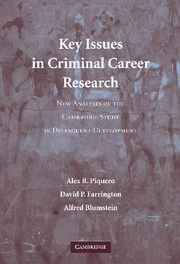 Key Issues in Criminal Career Research
Key Issues in Criminal Career Research Published online by Cambridge University Press: 30 July 2009
Researchers have long been interested in the patterning of criminal activity over the course of criminal careers (e.g., Greenberg, 1991; Rowe et al., 1990). Many years ago, Quetelet (1831) recognized that the propensity for crime varied with age. Using data on crimes committed against persons and property in France from 1826 to 1829, he found that crimes peaked in the late teens through the mid 20s. Since Quetelet's findings, many researchers have investigated the relationship between age and crime, across cultures and historical periods, and for a number of different crime types (Hirschi and Gottfredson, 1983). The relationship between age and crime has been one of the most studied issues within criminology (Farrington, 1986; Steffensmeier et al., 1989; Tittle and Grasmick, 1997).
The relationship between age and crime raises the question of the degree to which the aggregate pattern displayed in the age/crime curve (crime rising to a peak in the late teens and then declining more or less slowly depending on crime type) is similar to – or different from – the pattern of individual careers and what conclusions about individuals can be validly drawn from aggregate data. For example, how much does the observed peak of the aggregate age/crime curve reflect changes within individuals as opposed to changes in the composition of offenders? In other words, is the peak in the age/crime curve a function of active offenders committing more crime, or is it a function of more individuals actively offending during those peak years and fewer during the later years?
To save this book to your Kindle, first ensure [email protected] is added to your Approved Personal Document E-mail List under your Personal Document Settings on the Manage Your Content and Devices page of your Amazon account. Then enter the ‘name’ part of your Kindle email address below. Find out more about saving to your Kindle.
Note you can select to save to either the @free.kindle.com or @kindle.com variations. ‘@free.kindle.com’ emails are free but can only be saved to your device when it is connected to wi-fi. ‘@kindle.com’ emails can be delivered even when you are not connected to wi-fi, but note that service fees apply.
Find out more about the Kindle Personal Document Service.
To save content items to your account, please confirm that you agree to abide by our usage policies. If this is the first time you use this feature, you will be asked to authorise Cambridge Core to connect with your account. Find out more about saving content to Dropbox.
To save content items to your account, please confirm that you agree to abide by our usage policies. If this is the first time you use this feature, you will be asked to authorise Cambridge Core to connect with your account. Find out more about saving content to Google Drive.